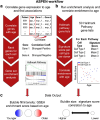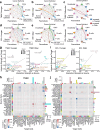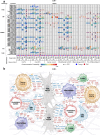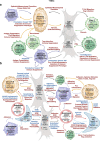This is a preprint.
Cell Populations in Human Breast Cancers are Molecularly and Biologically Distinct with Age
- PMID: 39483921
- PMCID: PMC11527348
- DOI: 10.21203/rs.3.rs-5167339/v1
Cell Populations in Human Breast Cancers are Molecularly and Biologically Distinct with Age
Abstract
Aging is associated with increased breast cancer risk and outcomes are worse for the oldest and youngest patients, regardless of subtype. It is not known how cells in the breast tumor microenvironment are impacted by age and how they might contribute to age-related disease pathology. Here, we discover age-associated differences in cell states and interactions in human estrogen receptor-positive (ER+) and triple-negative breast cancers (TNBC) using new computational analyses of existing single-cell gene expression data. Age-specific program enrichment (ASPEN) analysis reveals age-related changes, including increased tumor cell epithelial-mesenchymal transition, cancer-associated fibroblast inflammatory responses, and T cell stress responses and apoptosis in TNBC. ER+ breast cancer is dominated by increased cancer cell estrogen receptor 1 (ESR1) and luminal cell activity, reduced immune cell metabolism, and decreased vascular and extracellular matrix (ECM) remodeling with age. Cell interactome analysis reveals candidate signaling pathways that drive many of these cell states. This work lays a foundation for discovery of age-adapted therapeutic interventions for breast cancer.
Conflict of interest statement
Competing interests The authors declare no competing interests.
Figures







References
-
- Bray F. et al. Global cancer statistics 2022: GLOBOCAN estimates of incidence and mortality worldwide for 36 cancers in 185 countries. CA Cancer J. Clin. 74, 229–263 (2024). - PubMed
-
- Siegel R. L., Giaquinto A. N. & Jemal A. Cancer statistics, 2024. CA Cancer J. Clin. 74, 12–49 (2024). - PubMed
-
- Hutchins L. F., Unger J. M., Crowley J. J., Coltman C. A. Jr & Albain K. S. Underrepresentation of patients 65 years of age or older in cancer-treatment trials. N. Engl. J. Med. 341, 2061–2067 (1999). - PubMed
Publication types
Grants and funding
LinkOut - more resources
Full Text Sources
Molecular Biology Databases
Miscellaneous

